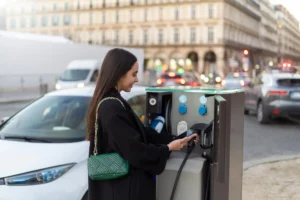
Home / EV Charging News / Electric Cars and Fleet Electrification for Delivery Services
As the world shifts towards sustainable transportation, delivery companies are pioneering the adoption of electric vehicles (EVs) to power their fleets. This article explores how delivery services are embracing electric cars and fleet electrification to enhance the sustainability and efficiency of last-mile delivery, marking a significant step towards a cleaner and greener logistics industry.
Last-mile delivery represents the final leg of a product’s journey, from the distribution center to the end consumer. It is a critical phase with unique challenges, including traffic congestion, emissions, and the demand for timely and efficient service. Electric vehicles are emerging as a solution to address these challenges while aligning with global sustainability goals.
Traditional delivery fleets, often powered by fossil fuels, contribute significantly to urban air pollution and greenhouse gas emissions. Recognizing the environmental impact of these operations, delivery companies are turning to electric cars as a cleaner and more sustainable alternative for last-mile delivery.
Amazon, a major player in the e-commerce industry, has committed to a sustainable future by ordering thousands of electric delivery vans. This initiative aims to have 100,000 electric vehicles in the Amazon delivery fleet by 2030, signaling a significant step towards a more sustainable last-mile delivery process.
Global delivery giant UPS is expanding its fleet electrification efforts. The company has been deploying electric delivery trucks and has committed to purchasing electric aircraft to further reduce its carbon footprint. UPS’s strategy focuses on integrating electric vehicles into various aspects of its logistics network.
One challenge in the adoption of electric vehicles for last-mile delivery is range anxiety—the fear of not having sufficient battery range to complete deliveries. Addressing this concern involves strategic route planning, deploying vehicles with adequate range, and continuously improving battery technology.
The future of electric fleet electrification relies on collaborative efforts and industry partnerships. Delivery companies, vehicle manufacturers, and charging infrastructure providers must work together to create a seamless and efficient ecosystem that supports the widespread adoption of electric cars for last-mile delivery.
One of the operational challenges in fleet electrification is managing the logistics of vehicle charging. Efficient route planning that incorporates charging stops, strategically located charging stations, and real-time monitoring of charging status are essential components in overcoming this challenge. Fleet managers are leveraging advanced fleet management systems to optimize charging logistics and minimize disruptions to delivery schedules.
While electric vehicles generally require less maintenance compared to their traditional counterparts, fleet managers need to adapt maintenance practices. Regular checks on battery health, software updates, and specialized training for maintenance crews are crucial to ensure the longevity and optimal performance of electric delivery vehicles.
Government incentives and policies play a pivotal role in accelerating the adoption of electric delivery fleets. Financial incentives, tax credits, and grants can significantly offset the initial costs of purchasing electric vehicles. Governments around the world are increasingly introducing supportive policies to encourage delivery companies to transition to electric fleets, aligning with broader sustainability goals.
Cities are implementing regulatory frameworks to restrict access to urban centers for vehicles with high emissions. Electric delivery fleets, being environmentally friendly, enjoy preferential treatment in terms of access and delivery windows. These regulatory measures provide additional motivation for delivery companies to invest in electric vehicles for last-mile delivery.
The transition to electric delivery fleets contributes directly to reducing the carbon footprint of last-mile logistics. With zero tailpipe emissions, electric vehicles play a critical role in mitigating air pollution and lowering greenhouse gas emissions. This environmental benefit aligns with the broader commitment to sustainability across industries.
While the upfront costs of electric vehicles can be a consideration, the long-term cost savings are substantial. Electric cars typically have lower fuel and maintenance costs, resulting in significant operational savings for delivery companies over the lifespan of their fleets. The economic benefits extend to reduced healthcare costs associated with air pollution-related illnesses.
Engaging with local communities is essential for the successful integration of electric delivery fleets. Delivery companies are investing in community outreach programs to educate residents about the environmental and health benefits of electric vehicles. Building support and positive perception within communities create a conducive environment for the adoption of electric last-mile delivery.
Delivery companies embracing electric fleets also benefit from showcasing corporate responsibility. Communicating a commitment to sustainability and environmentally conscious practices enhances the brand image. This positive association can lead to increased customer loyalty and support, further bolstering the business case for electric fleet adoption.
Beyond electric cars, companies are exploring innovative last-mile delivery solutions. Electric cargo bikes and drones are being tested to address specific delivery challenges, especially in urban areas. These technologies offer the potential for faster and more flexible deliveries, complementing the efforts of electric delivery vehicles.
The future of last-mile delivery involves closer integration with smart city initiatives. Electric delivery fleets can leverage smart city infrastructure, such as connected traffic systems and IoT sensors, to optimize routes, reduce congestion, and enhance overall efficiency. Collaborations between delivery companies and city planners will be instrumental in realizing these smart city synergies.
To support the growing demand for electric delivery fleets, collaborations with charging infrastructure providers are crucial. Building a robust network of charging stations, especially in urban centers and delivery hubs, ensures that electric vehicles have reliable access to charging. Such collaborations facilitate the scaling up of electric fleet operations.
In conclusion, the electrification of delivery fleets, powered by electric cars, marks a significant milestone in the journey towards sustainable logistics. By addressing operational challenges, leveraging government incentives, showcasing environmental and economic benefits, and actively engaging with communities, delivery companies are not just adopting a new mode of transportation but contributing to a cleaner and more sustainable future. As technology evolves and collaborations deepen, the electrification of last-mile delivery becomes a blueprint for environmentally conscious logistics on a global scale.
